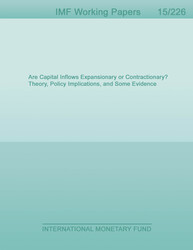
Are Capital Inflows Expansionary or Contractionary? Theory, Policy Implications, and Some Evidence
The workhorse open-economy macro model suggests that capital inflows are contractionary because they appreciate the currency and reduce net exports. Emerging market policy makers however believe that inflows lead to credit booms and rising output, and the evidence appears to go their way. To reconcile theory and reality, we extend the set of assets included in the Mundell-Fleming model to include both bonds and non-bonds. At a given policy rate, inflows may decrease the rate on non-bonds, reducing the cost of financial intermediation, potentially offsetting the contractionary impact of appreciation. We explore the implications theoretically and empirically, and find support for the key predictions in the data.
Publication date: October 2015
ISBN: 9781513500805
$18.00
Add to Cart by clicking price of the language and format you'd like to purchase
Available Languages and Formats
| English |
Prices in red indicate formats that are not yet available but are forthcoming.
Topics covered in this book
This title contains information about the following subjects.
Click on a subject if you would like to see other titles with the same subjects.
Economics- Macroeconomics , Economics / General , International - Economics , apital inflows , capital controls , foreign exchange intervention
Summary
Copyright © 2010 - 2024
Powered by:
AIDC



